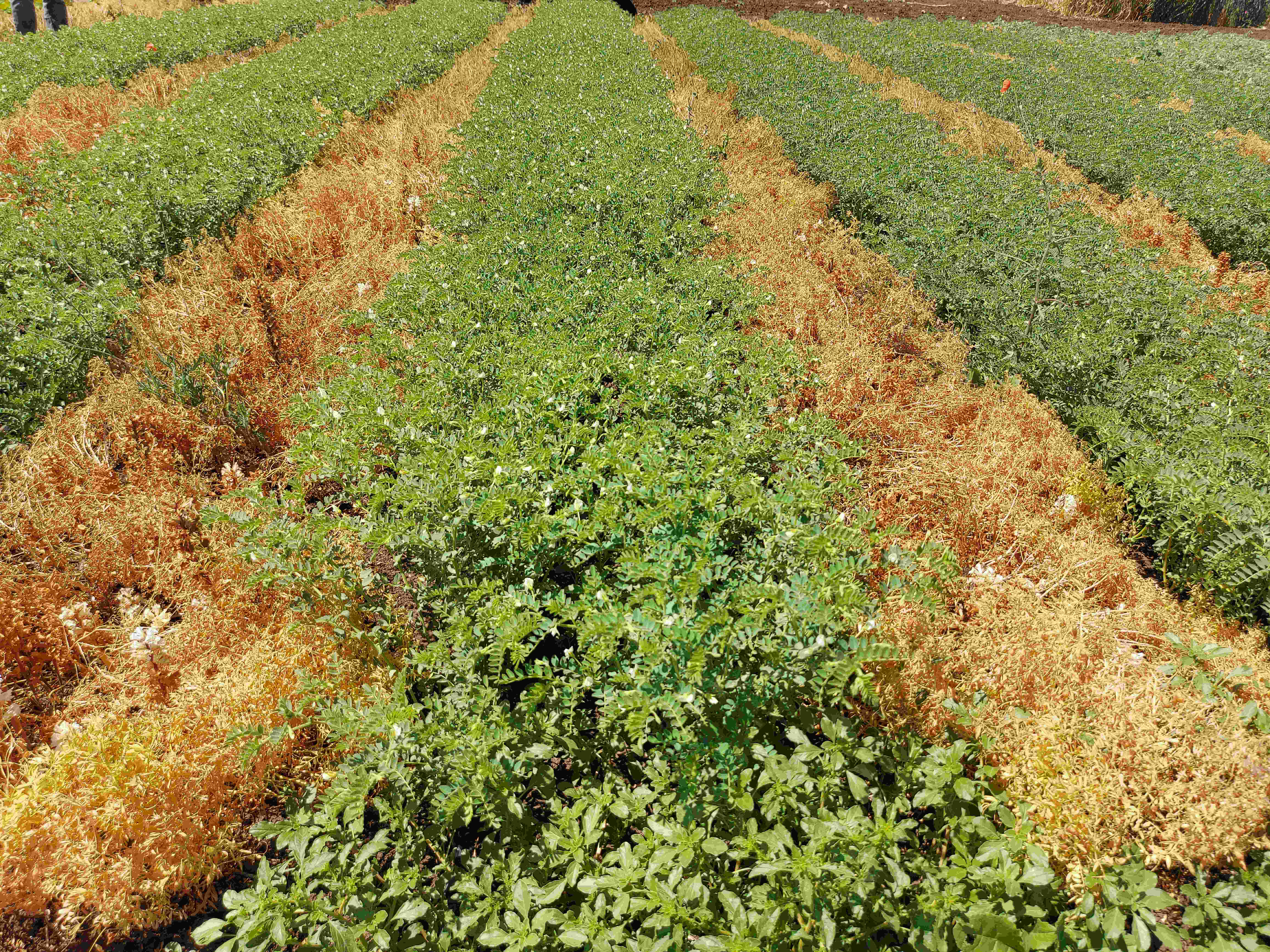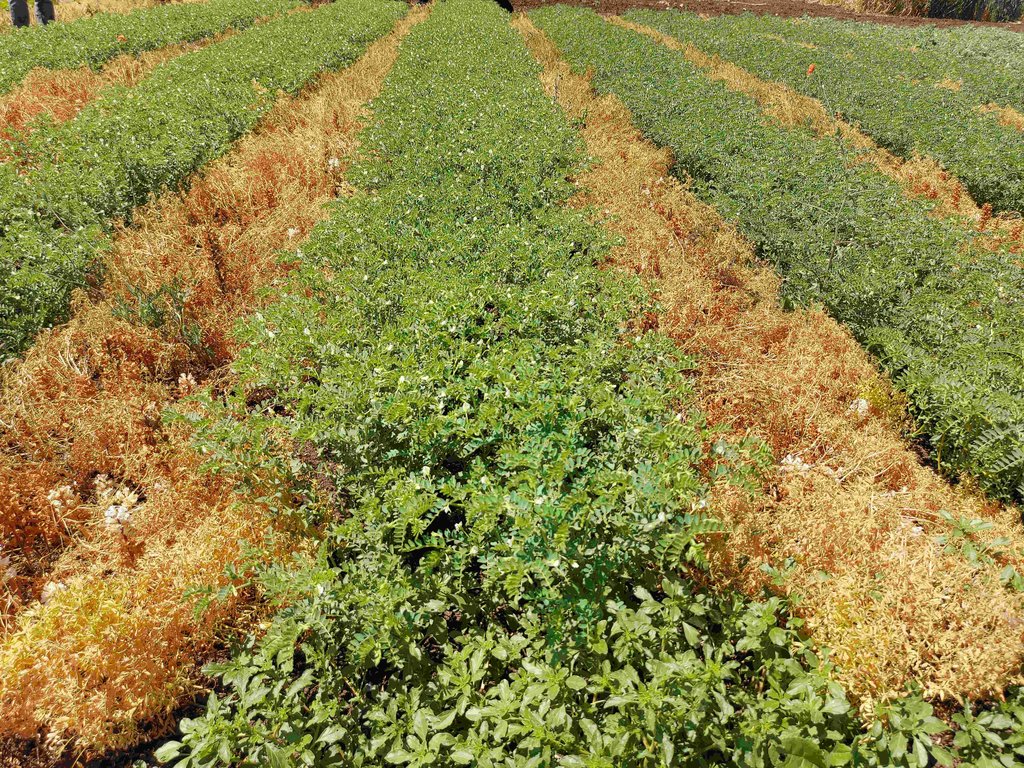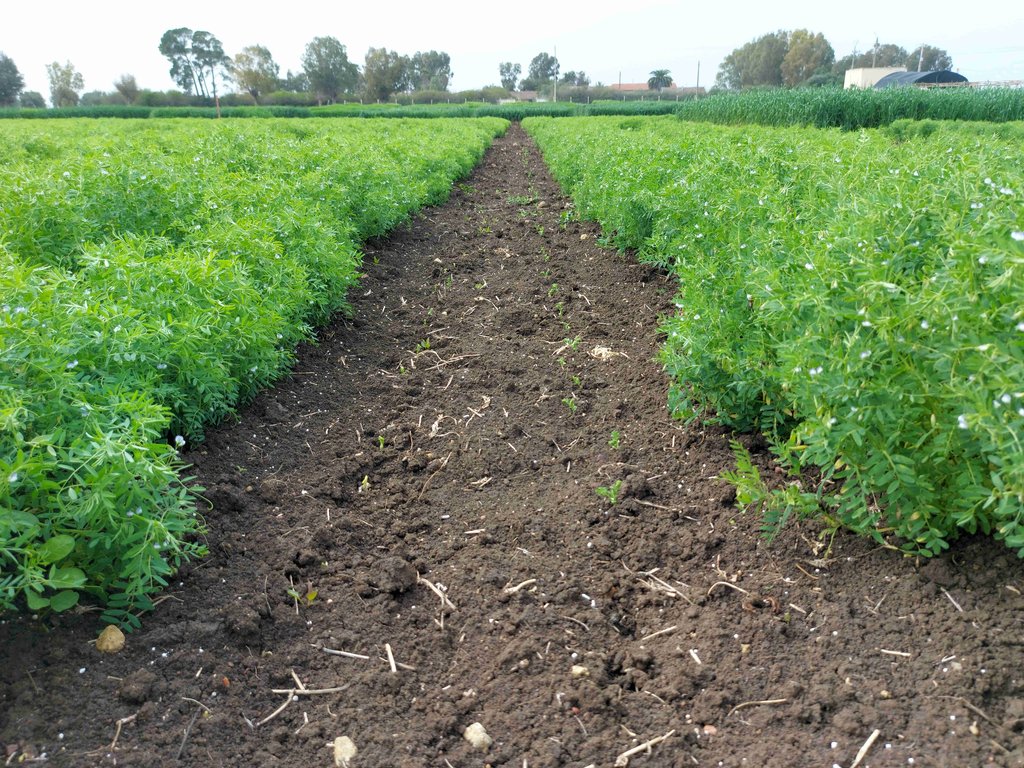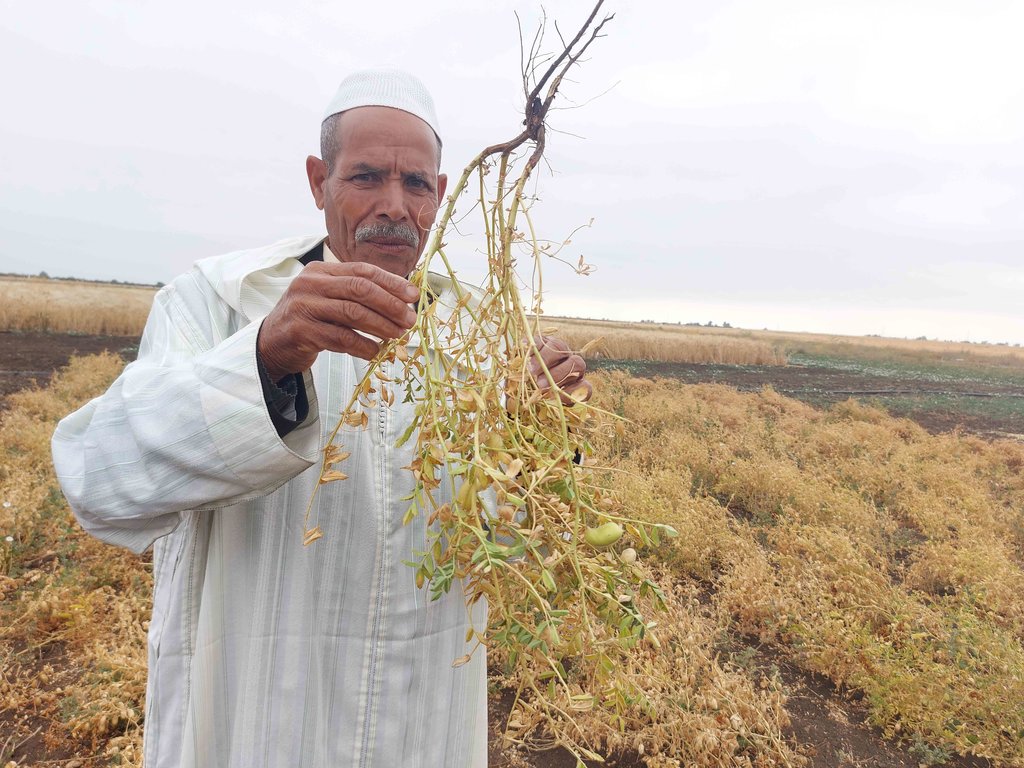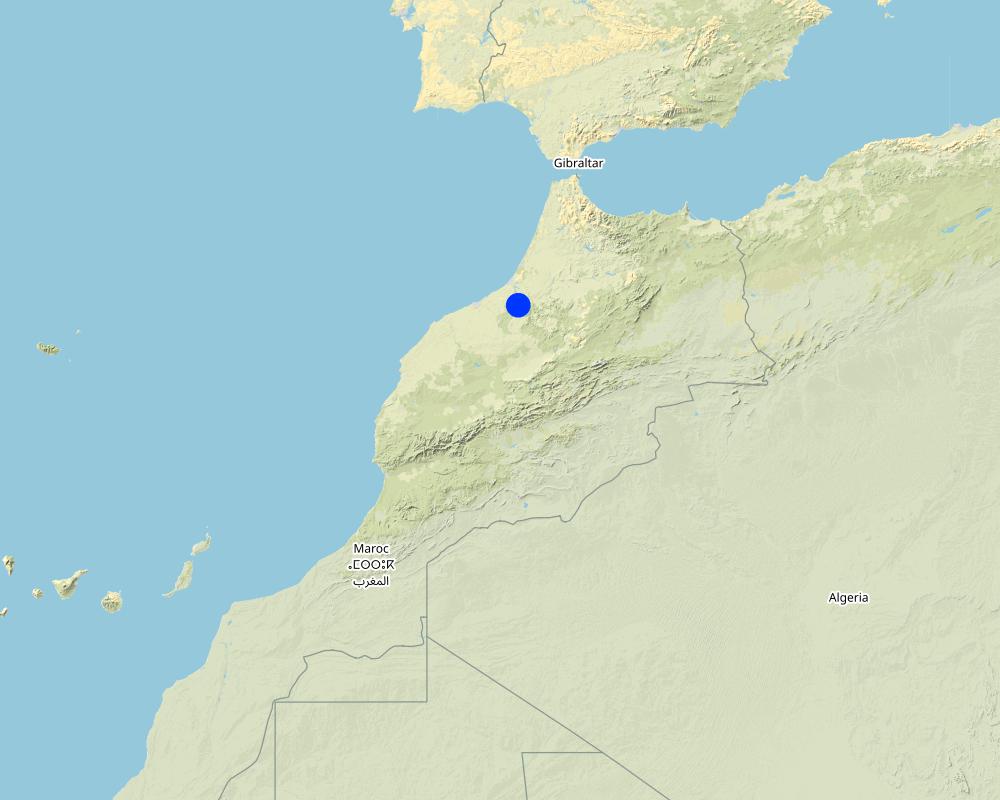Diversified Cropping System: Relay Intercropping of Lentils with Chickpeas [โมร็อกโก]
- ผู้สร้างสรรค์:
- การอัพเดท:
- ผู้รวบรวม: Fatma Rekik
- ผู้เรียบเรียง: Joren Verbist
- ผู้ตรวจสอบ: William Critchley, Rima Mekdaschi Studer
technologies_6416 - โมร็อกโก
ดูส่วนย่อย
ขยายทั้งหมด ย่อทั้งหมด1. ข้อมูลทั่วไป
1.2 รายละเอียดที่ติดต่อได้ของผู้รวบรวมและองค์กรที่เกี่ยวข้องในการประเมินและการจัดเตรียมทำเอกสารของเทคโนโลยี
วิทยากรหลัก
Agronomist:
Devkota Mina
International Center of Agriculture Research in the Dry Areas (ICARDA)
โมร็อกโก
Research Team Leader - Soils, Waters and Agronomy:
Vinay Nangia
International Center of Agriculture Research in the Dry Areas (ICARDA)
โมร็อกโก
ชื่อของโครงการซึ่งอำนวยความสะดวกในการทำเอกสารหรือการประเมินเทคโนโลยี (ถ้าเกี่ยวข้อง)
ICARDA Institutional Knowledge Management Initiativeชื่อขององค์กรซึ่งอำนวยความสะดวกในการทำเอกสารหรือการประเมินเทคโนโลยี (ถ้าเกี่ยวข้อง)
International Center for Agricultural Research in the Dry Areas (ICARDA) - เลบานอน1.3 เงื่อนไขการใช้ข้อมูลที่ได้บันทึกผ่านทาง WOCAT
ผู้รวบรวมและวิทยากรหลักยอมรับเงื่อนไขเกี่ยวกับการใช้ข้อมูลที่ถูกบันทึกผ่านทาง WOCAT:
ใช่
1.4 การเปิดเผยเรื่องความยั่งยืนของเทคโนโลยีที่ได้อธิบายไว้
เทคโนโลยีที่ได้อธิบายไว้นี้เป็นปัญหาของความเสื่อมโทรมโทรมของที่ดินหรือไม่ จึงไม่ได้รับการยอมรับว่าเป็นเทคโนโลยีเพื่อการจัดการที่ดินอย่างยั่งยืน:
ไม่ใช่
2. การอธิบายลักษณะของเทคโนโลยี SLM
2.1 การอธิบายแบบสั้น ๆ ของเทคโนโลยี
คำจำกัดความของเทคโนโลยี:
A Diversified Cropping System (DCS) results in a more resilient and productive cropping system. In this case, chickpeas were introduced as a relay intercrop between established lines of lentils. This not only had no negative effect on lentil yields, but also enabled the harvest of an extra crop: chickpeas.
2.2 การอธิบายแบบละเอียดของเทคโนโลยี
คำอธิบาย:
In the semi-arid regions of Morocco, agricultural production varies from year to year, but yields are generally declining because of climate change. Climate change is leading to more irregular rainfall and frequent extreme weather events. Wherever possible, there is a need to intensify agricultural systems to ensure food security while simultaneously increasing resilience.
Cultivating lentils (Lens culinaris) as a sole crop is common practice in rural Morocco. To intensify this cropping system, the International Centre for Agricultural Research Dry Areas (ICARDA) introduced chickpeas (Cicer arietinum) as a relay intercrop into the common lentil production system. Because chickpeas are planted within an already growing crop of lentils, this form of intercropping is termed "relay planting". Importantly, chickpeas do not affect the yields of lentils (0.837 + 0.19 t ha-1 yield in sole vs. 0.808 + 0.159 t ha-1 in intercrop) because they do not significantly compete for water and nutrients. With two crops harvested from the same piece of land, overall farm profits increase. Furthermore, this creates a more resilient production system because the farmer is not dependent on a single crop. Additionally, including chickpeas as a relay-intercrop extends the cropping season and prolongs the period where the soil is covered, consequently protecting it from degradation. An added advantage is that both chickpeas and lentils are leguminous, nitrogen-fixing crops that can improve soil fertility. Also, both crops have high cultural and culinary value locally. However, the technology has potential drawbacks as in years of extreme droughts, chickpeas require supplementary irrigation, especially during establishment. This is often unavailable to local farmers and may result in poor crop establishment and low yields.
In 2020-2022, ICARDA tested this Diversified Cropping System (DCS) on a trial field of half a hectare, in an area with average annual precipitation of 390 mm (based on 40 years of data). The system is implemented as follows. First, the field is prepared by ploughing. In December, lentils are mechanically seeded. Two rows of lentils are planted 15 cm apart. The spacing between each two-row pair is roughly 90 cm. Compound fertilizer is applied during seeding. In January, an herbicide is sprayed to control grassy weeds. The field is mechanically weeded twice, in mid-January and then again in February. Chickpeas are sown at the end of February also in paired lines (two rows 20 cm apart) also with compound fertilizer. Each pair of chickpea lines is planted between pairs of lentils. In March, the plots are manually weeded, and in April, the lentils are manually harvested and mechanically threshed. A single spray of insecticide is applied in April-May. Finally, in June, the chickpeas are mechanically harvested and have an average yield of 1.1 + 0.146 t ha-1.
This documentation illustrates an ICARDA innovation that is accessible since there are no establishment events and costs. This Diversified Cropping System improves a traditional system by introducing an additional crop, resulting in higher farm income and resilience to variable weather.
2.3 รูปภาพของเทคโนโลยี
2.5 ประเทศภูมิภาค หรือสถานที่ตั้งที่เทคโนโลยีได้นำไปใช้และได้รับการครอบคลุมโดยการประเมินนี้
ประเทศ:
โมร็อกโก
ภูมิภาค/รัฐ/จังหวัด:
Khémisset Province
ข้อมูลจำเพาะเพิ่มเติมของสถานที่ตั้ง :
Merchouch
ระบุการกระจายตัวของเทคโนโลยี:
- ใช้ ณ จุดที่เฉพาะเจาะจงหรือเน้นไปยังบริเวณพื้นที่ขนาดเล็ก
Is/are the technology site(s) located in a permanently protected area?
ไม่ใช่
Map
×2.6 วันที่การดำเนินการ
ระบุปีที่ใช้:
2021
2.7 คำแนะนำของเทคโนโลยี
ให้ระบุว่าเทคโนโลยีถูกแนะนำเข้ามาอย่างไร:
- ในช่วงการทดลองหรือการทำวิจัย
3. การจัดประเภทของเทคโนโลยี SLM
3.1 วัตถุประสงค์หลักของเทคโนโลยี
- ปรับปรุงการผลิตให้ดีขึ้น
- ปรับตัวเข้ากับการเปลี่ยนแปลงภูมิอากาศของโลก สภาพภูมิอากาศที่รุนแรงและผลกระทบ
- สร้างผลกระทบทางด้านเศรษฐกิจที่เป็นประโยชน์
3.2 ประเภทของการใช้ที่ดินในปัจจุบันที่ได้นำเทคโนโลยีไปใช้
Land use mixed within the same land unit:
ไม่ใช่

พื้นที่ปลูกพืช
- การปลูกพืชล้มลุกอายุปีเดียว
Annual cropping - Specify crops:
- legumes and pulses - lentils
- chickpeas
จำนวนของฤดูเพาะปลูกต่อปี:
- 1
Is intercropping practiced?
ใช่
If yes, specify which crops are intercropped:
Chickpeas
Is crop rotation practiced?
ไม่ใช่
3.3 Has land use changed due to the implementation of the Technology?
Has land use changed due to the implementation of the Technology?
- No (Continue with question 3.4)
3.4 การใช้น้ำ
การใช้น้ำของที่ดินที่มีการใช้เทคโนโลยีอยู่:
- จากน้ำฝน
แสดงความคิดเห็น:
By default, it is rainfed, unless there are droughts, in which case supplementary irrigation is introduced.
3.5 กลุ่ม SLM ที่ตรงกับเทคโนโลยีนี้
- การปรับปรุงดิน / พืชคลุมดิน
3.6 มาตรการ SLM ที่ประกอบกันเป็นเทคโนโลยี

มาตรการจัดการพืช
- A1: พืช/สิ่งปกคลุมดิน

มาตรการอนุรักษ์ด้วยการจัดการ
- M2: การเปลี่ยนแปลงของการจัดการหรือระดับความเข้มข้น
- M4: การเปลี่ยนแปลงช่วงเวลาให้เหมาะแก่การทำกิจกรรม
3.7 รูปแบบหลักของการเสื่อมโทรมของที่ดินที่ได้รับการแก้ไขโดยเทคโนโลยี

การกัดกร่อนของดินโดยน้ำ
- Wt (Loss of topsoil): การสูญเสียดินชั้นบนหรือการกัดกร่อนที่ผิวดิน

การกัดกร่อนของดินโดยลม
- Et (Loss of topsoil): การสูญเสียดินชั้นบน
3.8 การป้องกัน การลดลง หรือการฟื้นฟูความเสื่อมโทรมของที่ดิน
ระบุเป้าหมายของเทคโนโลยีกับความเสื่อมโทรมของที่ดิน:
- ลดความเสื่อมโทรมของดิน
4. ข้อมูลจำเพาะด้านเทคนิค กิจกรรมการนำไปปฏิบัติใช้ ปัจจัยนำเข้า และค่าใช้จ่าย
4.1 แบบแปลนทางเทคนิคของเทคโนโลยี
ข้อมูลจำเพาะด้านเทคนิค (แบบแปลนทางเทคนิคของเทคโนโลยี):
The symbols correspond to the following technical specifications:
A: Spacing between a row of lentil and a row of chickpea= 35 centimetres
B: Spacing between two rows of lentil in the same pair = 15 centimetres
C: Spacing between two rows of chickpea in the same pair = 20 centimetres
D: Spacing between two rows of lentil bordering a pair of chickpea= 90 - 95 centimetres
ผู้เขียน:
Fatma Rekik
วันที่:
05/09/2022
4.2 ข้อมูลทั่วไปเกี่ยวกับการคำนวณปัจจัยนำเข้าและค่าใช้จ่าย
ให้ระบุว่าค่าใช้จ่ายและปัจจัยนำเข้าได้รับการคำนวณอย่างไร:
- ต่อพื้นที่ที่ใช้เทคโนโลยี
ระบุขนาดและหน่วยพื้นที่:
1 Hectare
อื่นๆ หรือสกุลเงินประจำชาติ (ระบุ):
Moroccan Dirham
If relevant, indicate exchange rate from USD to local currency (e.g. 1 USD = 79.9 Brazilian Real): 1 USD =:
10.63
ระบุค่าเฉลี่ยของค่าจ้างในการจ้างแรงงานต่อวัน:
75
4.3 กิจกรรมเพื่อการจัดตั้ง
แสดงความคิดเห็น:
Chickepeas and lentils are annuals and they are cropped once a year under the conditions in question. As such, the above activities are listed under establishment (because they are only done once for every cropping season)
4.5 การบำรุงรักษาสภาพหรือกิจกรรมที่เกิดขึ้นเป็นประจำ
| กิจกรรม | ช่วงระยะเวลา/ความถี่ | |
|---|---|---|
| 1. | Field Ploughing | Prior to seeding |
| 2. | Lentil Seeding | December |
| 3. | Fertilizer Application (Lentil) | During seeding |
| 4. | Herbicide Application (Lentil) | January |
| 5. | First Mechanical Weeding (Lentil) | Mid January |
| 6. | Second Mechanical Weeding (Lentil) | Mid February |
| 7. | Chickpea Seeding | End of February |
| 8. | Fertilizer Application (Chickpea) | During seeding |
| 9. | Fungicide Application (Lentil) | February-March |
| 10. | Manual Weeding (Chickpea) | March |
| 11. | Lentil Harvesting | April |
| 12. | Insecticide Application (Chickpea) | April-May |
| 13. | Chickpea Harvesting | June |
แสดงความคิดเห็น:
The above activities are listed under recurrent because they are done more than once throughout the cropping season (and according to the need).
4.6 ค่าใช้จ่ายของปัจจัยนำเข้าและกิจกรรมที่เกิดขึ้นเป็นประจำที่ต้องการการบำรุงรักษา (ต่อปี)
| ปัจจัยนำเข้า | หน่วย | ปริมาณ | ค่าใช้จ่ายต่อหน่วย | ค่าใช้จ่ายทั้งหมดต่อปัจจัยนำเข้า | %ของค่าใช้จ่ายที่ก่อให้เกิดขึ้นโดยผู้ใช้ที่ดิน | |
|---|---|---|---|---|---|---|
| แรงงาน | Weeding (Lentil) | Person-Days | 10.0 | 75.0 | 750.0 | 100.0 |
| แรงงาน | Weeding (Chickpea) | Person-Days | 10.0 | 75.0 | 750.0 | 100.0 |
| แรงงาน | Lentil Harvesting | Person-Days | 10.0 | 75.0 | 750.0 | 100.0 |
| อุปกรณ์ | Plough | Machine-Hours | 3.0 | 150.0 | 450.0 | 100.0 |
| อุปกรณ์ | Lentil Seeder | Machine-Hours | 1.0 | 150.0 | 150.0 | 100.0 |
| อุปกรณ์ | Chickpea Seeder | Machine-Hours | 1.0 | 200.0 | 200.0 | 100.0 |
| อุปกรณ์ | Sprayer | Machine-Hours | 3.0 | 60.0 | 180.0 | 100.0 |
| อุปกรณ์ | Weeder | Machine-Hours | 2.0 | 100.0 | 200.0 | 100.0 |
| อุปกรณ์ | Lentil Thresher | Machine-Hours | 2.0 | 150.0 | 300.0 | 100.0 |
| อุปกรณ์ | Chickpea harvester | Machine-Hours | 2.5 | 300.0 | 750.0 | 100.0 |
| วัสดุด้านพืช | Lentil seeds | Kilogram | 45.0 | 8.0 | 360.0 | 100.0 |
| วัสดุด้านพืช | Chickpea seeds | Kilogram | 80.0 | 15.0 | 1200.0 | 100.0 |
| ปุ๋ยและสารฆ่า/ยับยั้งการเจริญเติบโตของสิ่งมีชีวิต (ไบโอไซด์) | Herbicide (for Lentil) | Litre | 1.0 | 170.0 | 170.0 | 100.0 |
| ปุ๋ยและสารฆ่า/ยับยั้งการเจริญเติบโตของสิ่งมีชีวิต (ไบโอไซด์) | Insecticide (for Chickpea) | Litre | 0.25 | 300.0 | 75.0 | 100.0 |
| ปุ๋ยและสารฆ่า/ยับยั้งการเจริญเติบโตของสิ่งมีชีวิต (ไบโอไซด์) | Fungicide (for Lentil) | Litre | 0.5 | 150.0 | 75.0 | 100.0 |
| ปุ๋ยและสารฆ่า/ยับยั้งการเจริญเติบโตของสิ่งมีชีวิต (ไบโอไซด์) | NPK 10:20:20 (for Lentil) | Kilogram | 100.0 | 3.0 | 300.0 | 100.0 |
| ปุ๋ยและสารฆ่า/ยับยั้งการเจริญเติบโตของสิ่งมีชีวิต (ไบโอไซด์) | NPK 10:20:20 (for Chickpea) | Kilogram | 100.0 | 3.0 | 300.0 | 100.0 |
| ค่าใช้จ่ายทั้งหมดของการบำรุงรักษาสภาพเทคโนโลยี | 6960.0 | |||||
| Total costs for maintenance of the Technology in USD | 654.75 | |||||
5. สิ่งแวดล้อมทางธรรมชาติและของมนุษย์
5.1 ภูมิอากาศ
ฝนประจำปี
- < 250 ม.ม.
- 251-500 ม.ม.
- 501-750 ม.ม.
- 751-1,000 ม.ม.
- 1,001-1,500 ม.ม.
- 1,501-2,000 ม.ม.
- 2,001-3,000 ม.ม.
- 3,001-4,000 ม.ม.
- > 4,000 ม.ม.
ระบุปริมาณน้ำฝนเฉลี่ยรายปี (ถ้ารู้) :หน่วย ม.ม.
390.00
ข้อมูลจำเพาะ/ความคิดเห็นเรื่องปริมาณน้ำฝน:
typical Mediterranean climate with winter rains
ระบุชื่อของสถานีตรวดวัดอากาศที่ใช้อ้างอิงคือ:
INRA + ICARDA weather data
เขตภูมิอากาศเกษตร
- กึ่งแห้งแล้ง
5.2 สภาพภูมิประเทศ
ค่าเฉลี่ยความลาดชัน:
- ราบเรียบ (0-2%)
- ลาดที่ไม่ชัน (3-5%)
- ปานกลาง (6-10%)
- เป็นลูกคลื่น (11-15%)
- เป็นเนิน (16-30%)
- ชัน (31-60%)
- ชันมาก (>60%)
ธรณีสัณฐาน:
- ที่ราบสูง/ที่ราบ
- สันเขา
- ไหล่เขา
- ไหล่เนินเขา
- ตีนเนิน
- หุบเขา
ระดับความสูง:
- 0-100 เมตร
- 101-500 เมตร
- 501-1,000 เมตร
- 1,001-1,500 เมตร
- 1,501-2,000 เมตร
- 2,001-2,500 เมตร
- 2,501-3,000 เมตร
- 3,001-4,000 เมตร
- > 4,000 เมตร
ให้ระบุถ้าเทคโนโลยีได้ถูกนำไปใช้:
- ไม่เกี่ยวข้อง
5.3 ดิน
ค่าเฉลี่ยความลึกของดิน:
- ตื้นมาก (0-20 ซ.ม.)
- ตื้น (21-50 ซ.ม.)
- ลึกปานกลาง (51-80 ซ.ม.)
- ลึก (81-120 ซ.ม.)
- ลึกมาก (>120 ซ.ม.)
เนื้อดิน (ดินชั้นบน):
- ปานกลาง (ดินร่วน ทรายแป้ง)
เนื้อดินล่าง (> 20 ซ.ม.ต่ำจากผิวดิน):
- ปานกลาง (ดินร่วน ทรายแป้ง)
อินทรียวัตถุในดิน:
- ปานกลาง (1-3%)
5.4 ความเป็นประโยชน์และคุณภาพของน้ำ
ระดับน้ำใต้ดิน:
5-50 เมตร
น้ำไหลบ่าที่ผิวดิน:
ไม่ดีหรือไม่มีเลย
คุณภาพน้ำ (ที่ยังไม่ได้บำบัด):
เป็นน้ำเพื่อการดื่มที่ไม่ดี (จำเป็นต้องได้รับการบำบัด)
Water quality refers to:
ground water
ความเค็มของน้ำเป็นปัญหาหรือไม่:
ไม่ใช่
กำลังเกิดน้ำท่วมในพื้นที่หรือไม่:
ไม่ใช่
5.5 ความหลากหลายทางชีวภาพ
ความหลากหลายทางชนิดพันธุ์:
- ต่ำ
ความหลากหลายของแหล่งที่อยู่:
- ต่ำ
5.6 ลักษณะของผู้ใช้ที่ดินที่นำเทคโนโลยีไปปฏิบัติใช้
อยู่กับที่หรือเร่ร่อน:
- อยู่กับที่
แนวทางการตลาดของระบบการผลิต:
- mixed (subsistence/ commercial)
รายได้ที่มาจากนอกฟาร์ม:
- < 10% ของรายได้ทั้งหมด
ระดับของความมั่งคั่งโดยเปรียบเทียบ:
- จน
เป็นรายบุคคล/ครัวเรือน:
- เป็นรายบุคคล/ครัวเรือน
ระดับของการใช้เครื่องจักรกล:
- การใช้เครื่องจักรหรือเครื่องยนต์
เพศ:
- หญิง
- ชาย
อายุของผู้ใช้ที่ดิน:
- วัยกลางคน
5.7 Average area of land used by land users applying the Technology
- < 0.5 เฮกตาร์
- 0.5-1 เฮกตาร์
- 1-2 เฮกตาร์
- 2-5 เฮกตาร์
- 5-15 เฮกตาร์
- 15-50 เฮกตาร์
- 50-100 เฮกตาร์
- 100-500 เฮกตาร์
- 500-1,000 เฮกตาร์
- 1,000-10,000 เฮกตาร์
- >10,000 เฮกตาร์
พิจารณาว่าเป็นขนาดเล็ก กลาง หรือขนาดใหญ่ (ซึ่งอ้างอิงถึงบริบทระดับท้องถิ่น):
- ขนาดเล็ก
- ขนาดกลาง
5.8 กรรมสิทธิ์ในที่ดิน สิทธิในการใช้ที่ดินและสิทธิในการใช้น้ำ
กรรมสิทธิ์ในที่ดิน:
- รายบุคคล ไม่ได้รับสิทธิครอบครอง
- รายบุคคล ได้รับสิทธิครอบครอง
สิทธิในการใช้ที่ดิน:
- รายบุคคล
สิทธิในการใช้น้ำ:
- รายบุคคล
Are land use rights based on a traditional legal system?
ใช่
5.9 การเข้าถึงบริการและโครงสร้างพื้นฐาน
สุขภาพ:
- จน
- ปานกลาง
- ดี
การศึกษา:
- จน
- ปานกลาง
- ดี
ความช่วยเหลือทางด้านเทคนิค:
- จน
- ปานกลาง
- ดี
การจ้างงาน (เช่น ภายนอกฟาร์ม):
- จน
- ปานกลาง
- ดี
ตลาด:
- จน
- ปานกลาง
- ดี
พลังงาน:
- จน
- ปานกลาง
- ดี
ถนนและการขนส่ง:
- จน
- ปานกลาง
- ดี
น้ำดื่มและการสุขาภิบาล:
- จน
- ปานกลาง
- ดี
บริการด้านการเงิน:
- จน
- ปานกลาง
- ดี
6. ผลกระทบและสรุปคำบอกกล่าว
6.1 ผลกระทบในพื้นที่ดำเนินการ (On-site) จากการใช้เทคโนโลยี
ผลกระทบทางด้านเศรษฐกิจและสังคม
การผลิต
การผลิตพืชผล
แสดงความคิดเห็น/ระบุ:
Overall crop production increased due to the introduction of an additional crop: chickpeas. No yield reduction was observed in lentils as a sole crop.
การเสี่ยงต่อความล้มเหลวในการผลิต
แสดงความคิดเห็น/ระบุ:
Due to the introduction of an additional crop: chickpeas, the risk to complete crop failure was reduced since if one crop fails another exists. This increases resilience.
If rainfall is evenly distributed throughout the growing season, farmers will get good harvests for both crops.
If rainfall occurs in the early season and the late season is dry, farmers will get good lentil harvests but not chickpeas.
Alternatively, if rainfall occurs in the late season with severe drought in the early season, farmers may get complete crop failure of lentils but a good harvest of chickpeas.
ความหลากหลายของผลิตภัณฑ์
แสดงความคิดเห็น/ระบุ:
Through the introduction of an additional crop: chickpeas, the overall system was diversified.
การจัดการที่ดิน
แสดงความคิดเห็น/ระบุ:
The introduction of additional crops increased the complexity of the system and its management. For example, planting in the standing lentil needs specialized machinery.
รายได้และค่าใช้จ่าย
ค่าใช่จ่ายของปัจจัยการผลิตทางการเกษตร
แสดงความคิดเห็น/ระบุ:
Additional planting material, labor and inputs are required for this cropping system. It may also require supplementary irrigation in the case of late-season drought occurrence.
รายได้จากฟาร์ม
แสดงความคิดเห็น/ระบุ:
Two crop harvests (both grains and straw) instead of one increases farm income.
ความหลากหลายของแหล่งผลิตรายได้
แสดงความคิดเห็น/ระบุ:
Two harvests of different crops: chickpeas and lentils instead of one diversified farming income streams. This system also allows employment opportunities outside of the main crop growing period.
ภาระงาน
แสดงความคิดเห็น/ระบุ:
The introduction of an additional crop complexifies the management and therefore increases the workload.
ผลกระทบด้านสังคมวัฒนธรรมอื่น ๆ
ความมั่นคงด้านอาหาร / พึ่งตนเองได้
แสดงความคิดเห็น/ระบุ:
Having two crops, especially protein-rich legumes promoted food and nutrition security.
SLM หรือความรู้เรื่องความเสื่อมโทรมของที่ดิน
แสดงความคิดเห็น/ระบุ:
Soil coverage for longer times due to the introduction of a second crop later in the season highlights its role in reversing land degradation
ผลกระทบด้านนิเวศวิทยา
ดิน
ความชื้นในดิน
แสดงความคิดเห็น/ระบุ:
There was no significant difference in soil moisture between sole lentils and intercropped lentils (with chickpeas) at the time of lentil harvesting.
สิ่งปกคลุมดิน
แสดงความคิดเห็น/ระบุ:
Having a second crop later in the season extends the period in which the soil is covered.
การสูญเสียดิน
แสดงความคิดเห็น/ระบุ:
Soil coverage mediated by the second crop reduces soil loss due to erosion.
การหมุนเวียนและการเติมของธาตุอาหาร
แสดงความคิดเห็น/ระบุ:
Both crops are leguminous meaning that they contribute to the supply of nitrogen to the soil.
6.3 การเผชิญและความตอบสนองของเทคโนโลยีต่อการเปลี่ยนแปลงสภาพภูมิอากาศที่ค่อยเป็นค่อยไป และสภาพรุนแรงของภูมิอากาศ / ภัยพิบัติ (ที่รับรู้ได้โดยผู้ใช้ที่ดิน)
การเปลี่ยนแปลงสภาพภูมิอากาศที่ค่อยเป็นค่อยไป
การเปลี่ยนแปลงสภาพภูมิอากาศที่ค่อยเป็นค่อยไป
| ฤดู | increase or decrease | เทคโนโลยีมีวิธีการรับมืออย่างไร | |
|---|---|---|---|
| อุณหภูมิประจำปี | เพิ่มขึ้น | ปานกลาง | |
| ฝนตามฤดู | ฤดูหนาว | ลดลง | ไม่ค่อยดี |
สภาพรุนแรงของภูมิอากาศ (ภัยพิบัติ)
ภัยพิบัติทางชีวภาพ
| เทคโนโลยีมีวิธีการรับมืออย่างไร | |
|---|---|
| โรคระบาด | ไม่ค่อยดี |
| การบุกรุกของแมลง / หนอน | ไม่ค่อยดี |
6.4 การวิเคราะห์ค่าใช้จ่ายและผลประโยชน์ที่ได้รับ
ผลประโยชน์ที่ได้รับเปรียบเทียบกับค่าใช้จ่ายในการจัดตั้งเป็นอย่างไร (จากมุมมองของผู้ใช้ที่ดิน)
ผลตอบแทนระยะสั้น:
ด้านบวก
ผลตอบแทนระยะยาว:
ด้านบวก
ผลประโยชน์ที่ได้รับเปรียบเทียบกับค่าใช้จ่ายในการบำรุงรักษาหรือต้นทุนที่เกิดขึ้นซ้ำอีก เป็นอย่างไร (จากมุมมองของผู้ใช้ที่ดิน)
ผลตอบแทนระยะสั้น:
ด้านบวก
ผลตอบแทนระยะยาว:
ด้านบวก
6.5 การปรับตัวของเทคโนโลยี
- ครั้งเดียวหรือเป็นการทดลอง
Of all those who have adopted the Technology, how many did so spontaneously, i.e. without receiving any material incentives/ payments?
- 0-10%
6.6 การปรับตัว
เทคโนโลยีได้รับการปรับเปลี่ยนเมื่อเร็วๆนี้ เพื่อให้ปรับตัวเข้ากับสภาพที่กำลังเปลี่ยนแปลงหรือไม่:
ไม่ใช่
6.7 จุดแข็ง / ข้อได้เปรียบ / โอกาสของเทคโนโลยี
| จุดแข็ง / ข้อได้เปรียบ / โอกาสในทัศนคติของผู้ใช้ที่ดิน |
|---|
| Diversified farm income |
| Reduces fallow period which helps to improve soil quality |
| Reduced risk of complete crop failure |
| จุดแข็ง / ข้อได้เปรียบ / โอกาสในทัศนคติของผู้รวบรวมหรือวิทยากรหลัก |
|---|
| Improved resilience due to diversified crops |
6.8 จุดอ่อน / ข้อเสียเปรียบ / ความเสี่ยงของเทคโนโลยีและวิธีการแก้ไข
| จุดอ่อน / ข้อเสียเปรียบ / ความเสี่ยงในทัศนคติของผู้ใช้ที่ดิน | มีวิธีการแก้ไขได้อย่างไร |
|---|---|
| Competition for resources (nutrients, water, etc.) between the two crops. | Providing supplementary irrigation/ fertilization. |
| Increased complexity and more labour demands of the system | The use of machinery and implementing a seasonal farming plan to distribute the farming tasks throughout the season. |
| จุดอ่อน / ข้อเสียเปรียบ / ความเสี่ยงในทัศนคติของผู้รวบรวมหรือวิทยากรหลัก | มีวิธีการแก้ไขได้อย่างไร |
|---|---|
| The overall system's higher susceptibility to legume-inflicting pests and diseases | Using adequate pest control/ integrated pest management techniques |
7. การอ้างอิงและการเชื่อมต่อ
7.1 วิธีการและแหล่งข้อมูล
- ไปเยี่ยมชมภาคสนาม การสำรวจพื้นที่ภาคสนาม
The field trial was managed by ICARDA scientists
วันที่เก็บรวบรวมข้อมูล(ภาคสนาม) :
30/04/2021
7.3 Links to relevant online information
ชื่อเรื่องหรือคำอธิบาย:
Diversified cropping systems for sustainable intensification of dryland family farming
URL:
https://hdl.handle.net/20.500.11766/66830
7.4 General comments
This technology is part of a series of technologies on Diversified Cropping Systems that test the incorporation of different crops into lentil production, namely onions (technologies_5992 - Morocco) and quinoa (technologies_5967 - Morocco)
ลิงก์และโมดูล
ขยายทั้งหมด ย่อทั้งหมดลิงก์
ไม่มีลิงก์
โมดูล
ไม่มีโมดูล


